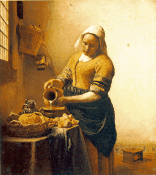20-11-2000
JAN
VERMEER
(1632-1675)
|
Dutch painter. He specialized in domestic
interiors, portraits and city views. His entire life was spent in Delft, where,
it has been suggested, he may have been trained by Leonaert Bramer or Carel
Fabritius. His work does indeed show an affinity with that of Fabritius, but
their relationship remains uncertain. Vermeer was a Master in the Delft painters'
guild from 1653, was elected Dean (hoofdman) in 1662-3 and 1670-71, and
was highly regarded in his lifetime, although he seems to have never been
particularly wealthy, leaving his wife and 11 children in debt at his death. His
name and reputation were almost forgotten until 1866 when the art critic Thoré
Burger published an essay attributing 66 pictures to him (only 34 paintings are
firmly attributed to him today). The few contemporary references to his
paintings all relate to surviving works, so it is unlikely that there were ever
many more - he may have been a slow worker and probably (like many Dutch
painters of this period) had another source of income - a trip to The Hague in
1672 to authenticate some paintings suggests that he may have been a picture
dealer.The few contemporary references to his paintings all relate to surviving
works, so it is unlikely that there were ever many more - he may have been a
slow worker and probably (like many Dutch painters of this period) had another
source of income - a trip to The Hague in 1672 to authenticate some paintings
suggests that he may have been a picture dealer. |

Click to see a larger image
The
Milkmaid
c. 1658-60
Oil on canvas
17 7/8x16 1/8 in. (45.5 x 41 cm)
Rijksmuseum, Amsterdam |
A chronology of Vermeer's work is complicated by the fact that
only three paintings are dated:
The
Procuress (1656, Dresden, Gemäldegalerie), The Astronomer
(1668, private collection), and
The
Geographer (1669, Frankfurt, Städelsches). Two pictures are
generally accepted as earlier than The Procuress; both are history
paintings, painted in a warm palette and in a relatively large format for
Vermeer - Christ in the House of Mary and Martha (Edinburgh, National
Gallery) and Diana and her Companions (The Hague, Mauritshuis). After The
Procuress almost all of Vermeer's paintings are of contemporary subjects in
a smaller format, with a cooler palette dominated by blues, yellows and greys.
It is to this period that practically all of his surviving works belong. They
are usually domestic interiors with one or two figures lit by a window on the
left. They are characterized by a serene sense of compositional balance and
spatial order, unified by an almost pearly light. Mundane domestic or
recreational activities become thereby imbued with a poetic timelessness (e.g. Woman
Reading a Letter at an Open Window, Dresden, Gemäldegalerie). To this
period also have been allocated Vermeer's two townscapes,
View
of Delft (The Hague, Mauritshuis) and
A
Street in Delft (Amsterdam, Rijksmuseum). A few of his paintings
show a certain hardening of manner and these are generally thought to represent
his late works. From this period come The Allegory of Faith (c 1670,
New York, Metropolitan Museum) and The Letter (c 1670, Amsterdam,
Rijksmuseum).
 The often
discussed sparkling pearly highlights in Vermeer's paintings have been linked to
his probable use of a
camera
obscura, the primitive lens of which would produce halation and, even more
noticeably, exaggerated perspective. Such effects can be seen in
Lady
at the Virginals with a Gentleman (London, Royal Collection).
Vermeer's interest in optics is also attested in this work by the accurately
observed mirror reflection above the lady at the virginals.
The often
discussed sparkling pearly highlights in Vermeer's paintings have been linked to
his probable use of a
camera
obscura, the primitive lens of which would produce halation and, even more
noticeably, exaggerated perspective. Such effects can be seen in
Lady
at the Virginals with a Gentleman (London, Royal Collection).
Vermeer's interest in optics is also attested in this work by the accurately
observed mirror reflection above the lady at the virginals.
The greatest of
these masters was born a generation after Rembrandt. He was Jan Vermeer van
Delft (1632-75). Vermeer seems to have been a slow and a careful worker. He did
not paint very many pictures in his lie. Few of them represent any important
scenes. Most of them show simple figures standing in a room of a typically Dutch
house. Some show nothing but a single figure engaged in a simple task, such as a
woman pouring out milk (figure). With Vermeer, genre painting has lost
the last trace of humorous illustration. His paintings are really still lifes
with human beings. It is hard to argue the reasons that make such a simple and
unassuming picture one of the greatest masterpieces of all time. But few who
have been lucky enough to see the original will disagree with me that it is
something of a miracle. One of its miraculous features can perhaps be described,
though hardly explained. It is the way in which Vermeer achieves complete and
painstaking precision in the rendering of textures, colours and forms without
the picture ever looking laboured or harsh. Like a photographer who deliberately
softens the strong contrasts of the picture without blurring the forms, Vermeer
mellowed the outlines and yet retained the effect of solidity and firmness. It
is this strange and unique combination of mellowness and precision which makes
his best paintings so unforgettable. They make us see the quiet beauty of a
simple scene with fresh eyes and give us an idea of what the artist felt when he
watched the light flooding through the window and heightening the colour of a
piece of cloth.
From
E.H. Gombrich,
"The Story of Art"
, Phaidon, London, 1995, Reprinted 1999
